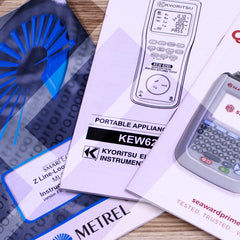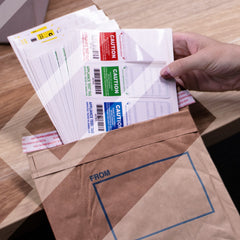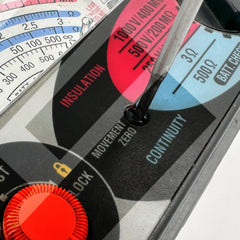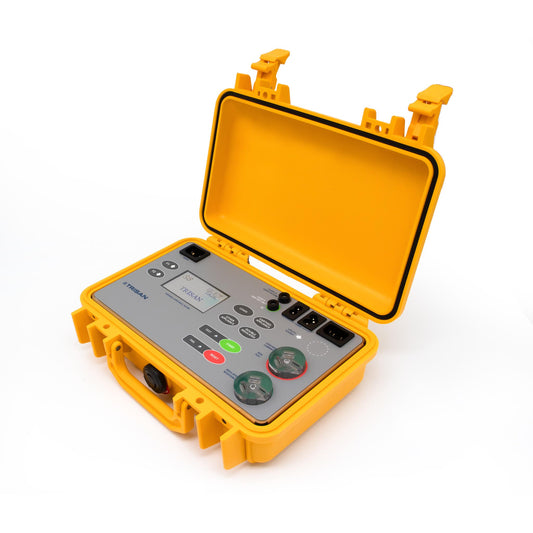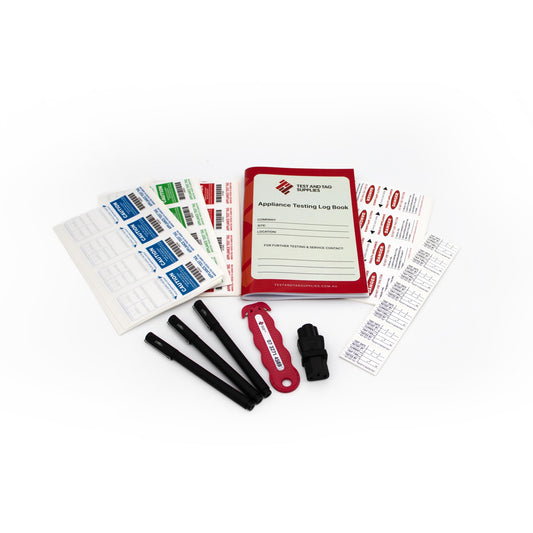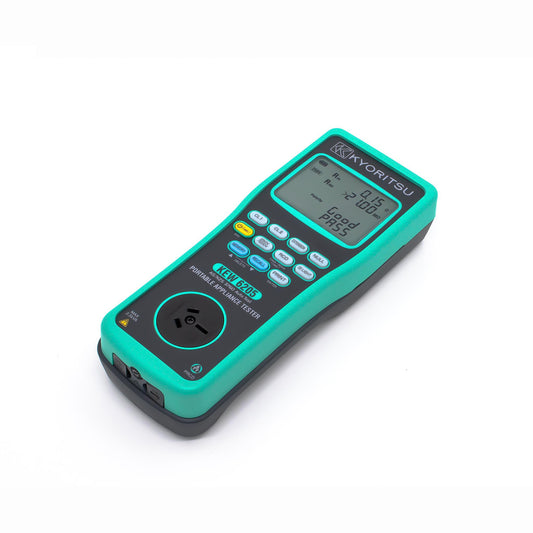The following guide may assist in your choice of appliance tester, but the best way to find out which is the most appropriate unit is by getting in contact with us.
Do I need current leakage (run) testing?
You require a current leakage testing if you have any appliances with electronic 'on' switches switches (those that must be energised to be in the 'on' position) eg Slow start drill, electronic microwaves etc?
Do I need an appliance 'off' warning?
We recommend an appliance 'off' warning wherever possible - particularly if the individual testing is not a test and tag specialist.
Do I need values in addition to a PASS/FAIL result?
You may prefer a PASS/FAIL result if:
- You test professionally for other organisations (this is a mandatory requirement in NZ according to AS/NZS3760)
- The organisation you work for has specifically requested that values of each test are recorded and documented
- In the event of a FAIL result, you will be required to fault find and repair
- Do I need battery operation?
- You will benefit from battery operation if:
- The appliance tester is not expected to be mostly stationary in during use
- You will be required to climb in hard to get places where trailing leads could be dangerous
- The majority of tests required will be on equipment which does not require a current leakage test
How long do the batteries last?
Battery life depends on the model and battery type. Some testers use disposable batteries whilst other use rechargeable. A single charge can last anywhere from a few hours to several days depending on the type and model. NiMh batteries will often require replacement after 1-3 years but could last less. Li-Ion may last a little longer but maybe more costly to replace. Alkaline batteries should never be charged and should be removed from equipment when not in use to avoid leakage.
Can I use an Insulation and Continuity Meter instead?
A Portable Appliance Tester will be more appropriate if:
- You have any appliances with electronic 'on' switches switches (those that must be energised to be in the 'on' position) eg Slow start drill, electronic microwaves etc
- You would like the test device to determine an unambiguous PASS/FAIL for you
- You would like some features to help ensure tests are carried out correctly
- You are not comfortable with using probes manually
- You are concerned about testing incorrectly and damaging equipment
- Do I need high current earth bond testing?
- High current earth bond testing may be preferential if:
- You will be using the appliance tester for end-of-line manufacturing testing
- The organisation has specifically requested that high current earth bond testing be performed
- Note that whilst more thorough, high current earth bond testing is not a requirement under AS3760. Due to portability demands of users, high current earth bond testing is generally no longer a standard feature of appliances testers. High current earth bond capable testers tend to be heavier, less portable and more cumbersome.
Do I need an RCD / Safety Switch trip time testing feature?
Consider purchasing an RCD trip time tester (or a unit with an integrated feature) if:
- You regularly use portable or fixed RCD's in the work place
- You will be testing professionally and providing a service to others
- You think you may be required to test RCD's in the future and would like the facility as an integrated feature.
Can I test RCD’s at the switchboard using an Appliance Tester and probes?
Testing RCD’s at the switchboard is not recommended due to the higher risk posed and maybe unnecessary. Specialist CATIII or CATIV rated test equipment is required in these environments. Appliance testers are primarily designed for testing appliances from and work from outlet sockets. For testing at a switchboard an installation tester or RCD tester with a CATIII or CATIV safety rating is recommend along with appropriate PPE, safe work methods and a risk assessment.
Do I need an isolation transformer?
Most appliance testers with RCD testing capabilities now feature integrated isolation from fixed RCD’s. However, some appliance testers may still require an isolation transformer – particularly for non-latching RCD’s. Check the manufacturers specifications before you buy.
How long will an appliance tester last?
The life expectancy of an appliance tester will vary according to usage, care and maintenance and the environment it is deployed. We often calibrate instruments over 10 years old. However, it’s important to remember that appliance testers are sensitive test and measurement equipment and need to be looked after, serviced and maintained accordingly.
Do I need a data logging facility in the tester?
Data logging facilities maybe cost beneficial if:
- You have hundreds of appliances in the workplace requiring testing
- You are testing professionally
- Your company has requested that values are recorded in addition to PASS/FAIL results
Do all recording appliance testers recognise equipment on retest?
No – not all recording appliance testers can recall previously entered information – even those with barcode scanners. Some only ‘log’ the entered information at the time of test. Consult with our team for which solution suits you best.
What do recording/logging testers record?
This varies on the model and supporting software. Some only record basics like date and time along with test results while others record descriptions, asset ID and can even take photographs. We recommend consulting with one of our team before deciding.
Can I use an Apple Mac or iOS devices with my appliance tester?
Appliance testing software and integrated tablet database software tend be compatible only with Microsoft Windows or Android Apps. We recommend consulting with one of our team regarding compatibility or consulting with the manufactures’ documentation.
Can I record other information in the software?
Appliance testers and related software tend to be dedicated to appliance testing information only. A handful of systems can record non-electrical test information. If you need to record data from other sources such as non-electrical asset inspections contact us first to make sure we help you make the right choice.
Can I test 3-phase equipment with an appliance tester?
The vast majority of appliance testers are designed for single phase use. Most 3-phase equipment requires leakage testing to be performed in order to meet the requirements AS/NZS3760. Some single-phase appliance testers have optional leakage testing accessories or adaptors. Other models feature point to point testing for earth continuity and insulation resistance. A small range of dedicated 3-phase appliance testers are available. We recommend you consult with our team before making a decision.
Do I need a tag printer?
A tag printer maybe cost and time beneficial if:
- You have hundreds of appliances in the workplace requiring regularly testing
- You are testing professionally
- You have over $2000.00 to spend on an appliance testing system
Do I need an audible FAIL indicator?
Audible FAIL indicator will sound an alarm in the event of an appliance FAIL. As 99% of the appliances you check will probably PASS, it's helpful to have an additional alarm when an appliance FAILS.
Do I need a double insulation connection check?
Only the Trisan S8 and S8DL has this feature. When testing a double insulated appliance, the Trisan S8 ensures that the probe that will measure any breakdown in insulation (which might cause a FAIL) has been connected to the appliance either directly or using the Insulation Cloak. It helps ensure that tests are carried out correctly and accurately.
Do I need to purchase an insulation cloak?
An insulation cloak is a piece of metal mesh cloth which can be wrapped around a double insulated appliance during an insulation test. The cloak covers the appliance with a conductive surface. By covering the appliance with the cloak, if any breakdown in resistance is present on the surface of the appliance, the appliance tester will measure the breakdown more effectively. Aluminium foil can also be used for this purpose but is clumsy, time consuming and messy. The use of an insulation cloak is not required under AS/NZS3760:2022.
Does the tester I'm purchasing need a visual and/or audible warning before performing a powered run test?
Yes, during a powered test the appliance will operate. For safety reasons, a pre-test warning is essential. This maybe in the form of a prompt screen, a warning noise, or both.
What is point-to-point testing?
Point to point testing refers to testing using two probes for either continuity or insulation resistance – like as would be used with an insulation and continuity meter. It’s a useful feature for those fault finding or testing 3-phase with probes.
Do I need programable test settings?
Most lower cost testers feature set test sequences to test to the thresholds detailed in AS/NZS3760 and are not editable. Others have completely programable test sequences where users can decide the PASS/FAIL thresholds and design custom sequences. If you test professionally or in high volume programmable test sequences maybe beneficial.
How much do I need to spend on a tester?
An appliance tester capable of testing in accordance with the AS/NZS3760:2022.
Appliance tester will cost from $795.00 + GST to around $4000.00 + GST
Annual calibration will cost from $120.00 + GST to $275.00 + GST
An appliance tester capable of testing in accordance with the AS/NZS3760:2022 and recording results to memory for download to a PC.
Appliance tester will cost from around $1000.00 + GST to $4000.00 + GST
Annual calibration will cost from $160.00 + GST to $275.00 + GST
An appliance testing package capable of recording results to memory and automatically creating a database - referring new test results to previous test information (but without a printer).
A recording and database system without a tag printer will cost upward of around $1800.00 + GST.
You may incur additional software subscription fees.
Annual calibration will cost from $160.00 + GST to $275.00 + GST
An appliance testing package which recording results to memory, creating a database, and automatically printing a test tag.
Systems will cost upward of $2400.00 + GST to $8000.00 + GST
Systems that ‘recognise’ previously tested equipment will be upward of $3000.00 + GST

